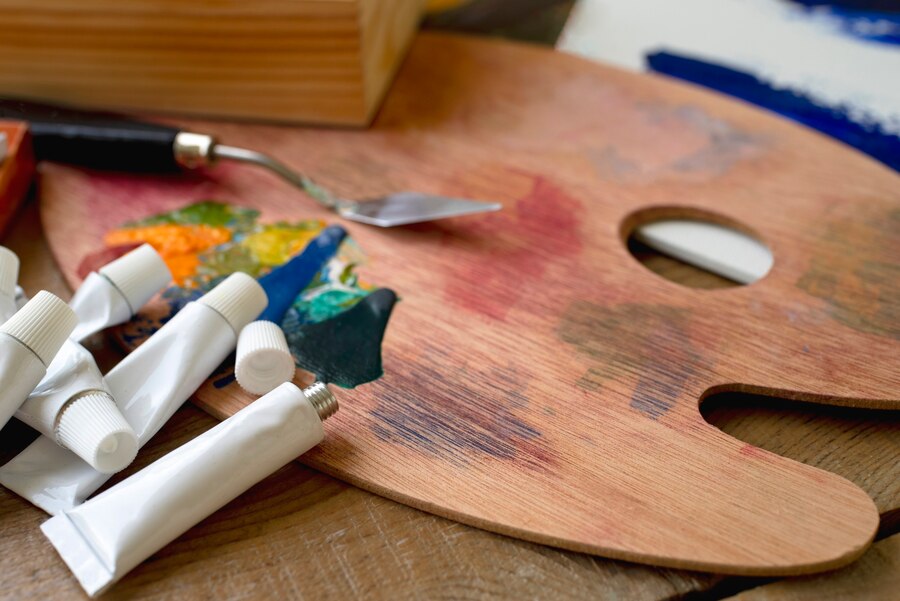
Oil painting has long been revered as one of the most expressive and enduring art forms, dating back centuries to the Renaissance period. Artists such as Leonardo da Vinci, Rembrandt, and Vincent van Gogh have immortalized their works using oil paints, blending pigments with various mediums to create rich, textured, and luminous pieces of art. However, over time, numerous myths and misconceptions have surfaced about oil painting mediums, often leading to confusion among beginners and even seasoned artists. In this in-depth guide, we will debunk these myths and provide clarity about oil painting mediums, their uses, and their true impact on an artist’s work. Whether you’re new to oil painting or looking to refine your techniques, understanding the truth about these mediums will enhance your creative process and allow you to experiment with confidence.
Myth #1: Oil Paints Take Forever to Dry
One of the most persistent myths about oil painting is that oil paints take an unreasonably long time to dry. While it is true that oil paints have a slower drying time compared to acrylics or watercolors, the timeline varies significantly based on factors such as pigment type, thickness of application, and the medium used. Certain oil painting mediums, such as alkyd mediums (e.g., Liquin by Winsor & Newton), can accelerate drying times, allowing artists to layer and complete their paintings faster. Additionally, oil paint drying times can be manipulated by using different techniques, such as applying thinner layers, working in a well-ventilated space, or mixing in drying agents like cobalt drier. While some pigments like titanium white and ivory black dry slowly, others like burnt umber and raw sienna dry much faster. Instead of avoiding oil painting due to drying time concerns, artists should explore these options to better control their workflow.
Myth #2: Oil Paints Are Toxic and Unsafe
Many artists worry about the safety of oil paints and mediums, believing them to be inherently toxic. This misconception arises mainly due to the strong odor of solvents like turpentine and mineral spirits, which were traditionally used for thinning paint and cleaning brushes. However, modern advancements in oil painting materials have led to the development of non-toxic alternatives, such as Gamsol by Gamblin and Weber’s Turpenoid, both of which are low-odor and safer for indoor use. Additionally, not all oil paints contain hazardous materials—many professional brands now offer cadmium-free and lead-free alternatives, ensuring a safer painting experience. To further minimize health risks, artists can adopt simple safety measures such as using adequate ventilation, wearing gloves, and opting for brush soaps instead of harsh solvents for cleaning.
Myth #3: You Must Use Linseed Oil for Every Oil Painting
Linseed oil is undoubtedly one of the most popular and commonly used oil painting mediums, but it is not the only option available. In fact, different oils have unique characteristics that affect drying time, gloss, and texture. For example, walnut oil (M. Graham Walnut Oil) offers a slower drying time and a smoother finish, making it ideal for blending and glazing. Poppyseed oil, on the other hand, is a non-yellowing alternative, often preferred for mixing light colors. Stand oil, a thickened form of linseed oil, produces a glossy and enamel-like surface when used in glazing techniques. Rather than limiting oneself to linseed oil, artists should experiment with different oils to achieve desired effects in their paintings.
Myth #4: Oil Paintings Must Be Varnished Immediately After Completion
Some artists believe that a painting should be varnished as soon as it is dry to the touch. However, this is a critical mistake that can lead to issues such as cracking or dulling of colors. Oil paintings require a longer curing time—often six months to a year—before they can be safely varnished. Applying varnish too soon can trap moisture and cause permanent damage. Instead of rushing the process, artists can use retouch varnish (Damar Retouch Varnish by Winsor & Newton) if they need to unify the appearance of a painting while waiting for the final varnish application. Understanding the correct timing for varnishing ensures the longevity and preservation of an artwork.
Comparison Table: Popular Oil Painting Mediums
| Medium Type | Drying Time | Finish | Best Used For |
|---|---|---|---|
| Linseed Oil | Moderate | Glossy | General use, traditional layering |
| Walnut Oil | Slow | Matte | Smooth blending, non-yellowing |
| Poppyseed Oil | Very Slow | Satin | Light colors, delicate glazing |
| Stand Oil | Slow | Glossy | High-gloss finishes, thick layers |
| Alkyd Mediums | Fast | Varies | Quick drying, layering |
FAQs
1. Can I mix different oil painting mediums together?
Yes, artists often mix different mediums to customize the properties of their paint. For example, adding a small amount of stand oil to linseed oil can create a smoother and more lustrous finish.
2. Do I need to use a medium when painting with oils?
Not necessarily. Many artists paint directly with oil colors from the tube without adding mediums. However, mediums can enhance paint flow, drying time, and texture, depending on the desired effect.
3. How can I clean my brushes without using toxic solvents?
A great alternative to traditional solvents is vegetable oil or baby oil, followed by washing with mild soap. Additionally, brands like The Masters Brush Cleaner provide effective non-toxic solutions.
4. What is the best oil painting medium for beginners?
For beginners, linseed oil or walnut oil is recommended as they are easy to use, widely available, and provide good results without significantly altering paint consistency.
Conclusion
The world of oil painting is rich, diverse, and full of creative potential, yet myths and misconceptions often discourage aspiring artists from exploring its full range of possibilities. By debunking these common myths, we’ve revealed that oil painting mediums are far more versatile and user-friendly than many believe. From the misconception of excessively long drying times to the fear of toxicity, the reality is that modern advancements have made oil painting more accessible than ever. Whether using traditional linseed oil, exploring alternative oils like walnut or poppyseed, or leveraging fast-drying alkyd mediums, artists can tailor their materials to match their unique artistic style and workflow. Moreover, understanding proper varnishing techniques, brush cleaning methods, and safe studio practices ensures a healthier and more enjoyable painting experience. The key takeaway is simple: rather than being bound by outdated myths, embrace the true potential of oil painting mediums and unlock your creative expression with confidence!
